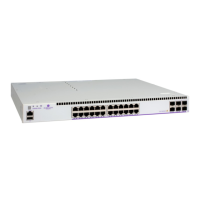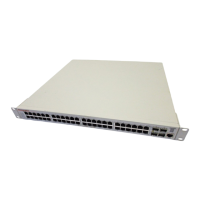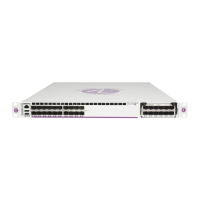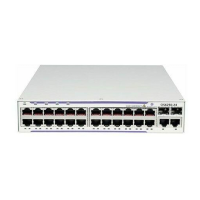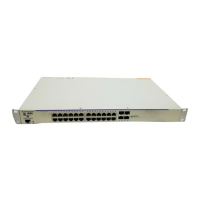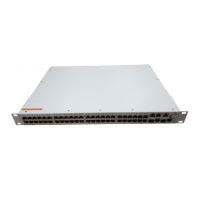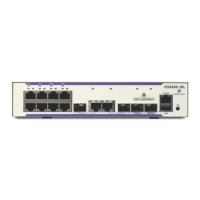Do you have a question about the Alcatel-Lucent OmniSwitch AOS Release 6 and is the answer not in the manual?
Details CLI commands for managing files and directories, categorized into directory, file, and utility commands.
Discusses various methods for loading software to and from the switch, including FTP, TFTP, and Zmodem.
Explains how to set and configure the switch's system clock, including date, time, time zone, and DST.
Details the Secure Shell feature for secure remote login, file transfer, and its components.
Explains how to configure the switch using SNMP via CLI, NMS applications, and MIB browsers.
Guides on designating NTP servers, setting poll times, versions, and marking servers as preferred.
Explains how to set up and use MD5 encryption authentication for NTP servers and clients.
Details how the CMM software directory structure allows returning to a previous, more reliable version of files.
Defines commands to manipulate files in the directory structure of a single CMM or stackable switch.
Guides on copying validated software from the working directory to the certified directory for reliability.
Covers user awareness of CMM directory structure management with redundant CMMs.
Details the ISSU feature for patching CMM images with minimal disruption to data traffic.
Details how to enable/disable MAC Retention and configure duplicate MAC address traps.
Explains how to create a new user account using the `user` command with username and password.
Covers setting global password requirements like minimum size, character types, expiration, and history.
Covers global settings for user lockout, including window, threshold, duration, and manual locking/unlocking.
Explains how to configure user privileges, determining read-only or read-write access to command domains and families.
Guides on configuring SNMP access for users, including authentication and encryption settings.
Details how to configure end-user profiles to restrict users to specific command areas, ports, and VLANs.
Explains how to authenticate users for switch management access via local database or third-party servers.
Outlines the general steps for setting up authenticated switch access, including server setup and interface configuration.
Provides quick steps for configuring ASA, including user accounts, RADIUS/LDAP servers, and authentication commands.
Guides on configuring management interfaces (Telnet, FTP, HTTP, SSH, SNMP) for authenticated access.
Explains how to configure accounting servers to track network resources and user activity.
Details CLI commands for managing files and directories, categorized into directory, file, and utility commands.
Discusses various methods for loading software to and from the switch, including FTP, TFTP, and Zmodem.
Explains how to set and configure the switch's system clock, including date, time, time zone, and DST.
Details the Secure Shell feature for secure remote login, file transfer, and its components.
Explains how to configure the switch using SNMP via CLI, NMS applications, and MIB browsers.
Guides on designating NTP servers, setting poll times, versions, and marking servers as preferred.
Explains how to set up and use MD5 encryption authentication for NTP servers and clients.
Details how the CMM software directory structure allows returning to a previous, more reliable version of files.
Defines commands to manipulate files in the directory structure of a single CMM or stackable switch.
Guides on copying validated software from the working directory to the certified directory for reliability.
Covers user awareness of CMM directory structure management with redundant CMMs.
Details the ISSU feature for patching CMM images with minimal disruption to data traffic.
Details how to enable/disable MAC Retention and configure duplicate MAC address traps.
Explains how to create a new user account using the `user` command with username and password.
Covers setting global password requirements like minimum size, character types, expiration, and history.
Covers global settings for user lockout, including window, threshold, duration, and manual locking/unlocking.
Explains how to configure user privileges, determining read-only or read-write access to command domains and families.
Guides on configuring SNMP access for users, including authentication and encryption settings.
Details how to configure end-user profiles to restrict users to specific command areas, ports, and VLANs.
Explains how to authenticate users for switch management access via local database or third-party servers.
Outlines the general steps for setting up authenticated switch access, including server setup and interface configuration.
Provides quick steps for configuring ASA, including user accounts, RADIUS/LDAP servers, and authentication commands.
Guides on configuring management interfaces (Telnet, FTP, HTTP, SSH, SNMP) for authenticated access.
Explains how to configure accounting servers to track network resources and user activity.
| Product Family | OmniSwitch |
|---|---|
| Software Release | AOS Release 6 |
| Category | Switch |
| Operating System | Alcatel-Lucent Operating System (AOS) |
| IPv6 Support | Yes |
| Multicast Support | IGMP Snooping, PIM-SM, PIM-DM |
| Stacking Support | Yes |
| Layer Support | Layer 2 and Layer 3 |
| Management Interface | CLI, WebView, SNMP |
| Management Protocols | SNMP, RMON, SSH, Telnet |
| VLAN Support | IEEE 802.1Q VLAN tagging |
| Security Features | 802.1X, ACLs, Secure Shell (SSH) |
| Redundancy Protocols | VRRP, LACP |
| Switching Capacity | Varies by model within the OmniSwitch family |
| Forwarding Rate | Varies by model within the OmniSwitch family |


